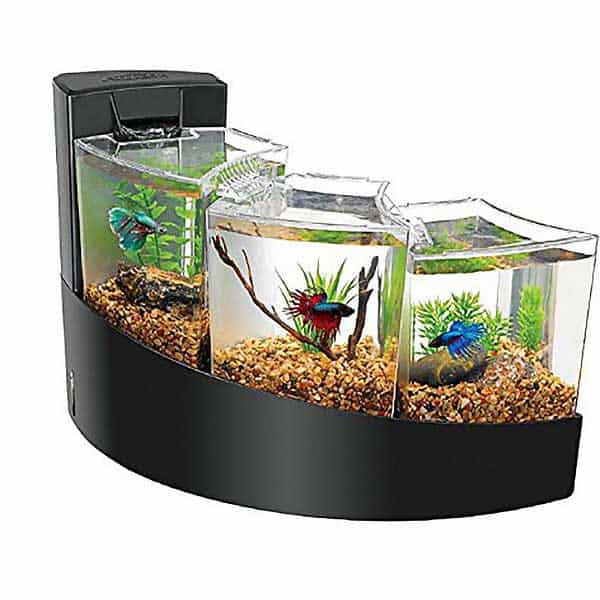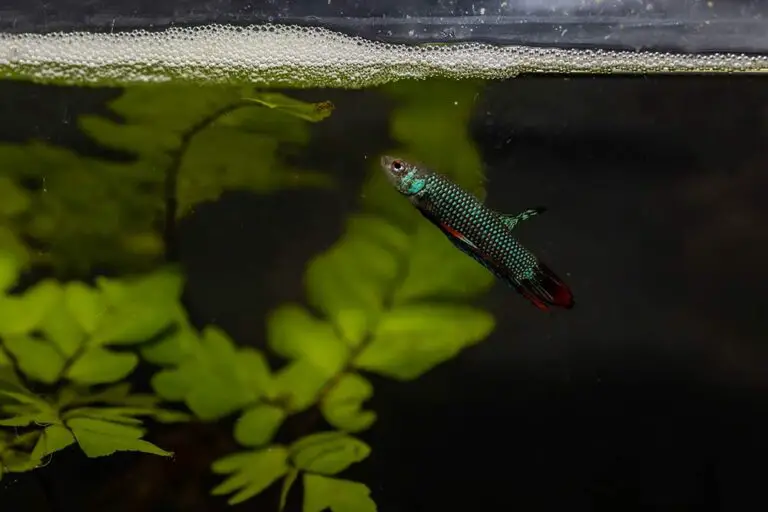Can Male And Female Betta Fish Live Together (Tips for success!)
Betta fish are widely known for their aggression toward each other and other fish, so can male and female betta fish live together under any circumstances, or is it a disaster waiting to happen?
Male and female betta fish can live together in some circumstances, but you need to understand their needs and requirements. It helps to also understand the triggers that can lead to fighting.

So can you put a male and female betta fish together? This short article answers the question and provides you with some tips to improve your success when introducing a male and female betta.
I also recommend reading my betta fish care and species guide.
Can Betta Fish Live Together?
Betta fish can live together, but it’s not recommended. It can be difficult, takes a lot of work, and has a high potential for failure. Betta fish are naturally territorial and aggressive toward each other, especially males. A large and heavily planted tank offers some boundaries, but don’t expect it to work out in most cases.
There are plenty of ways to keep multiple betta fish without the need to keep them in the same tank. The most common method is to purchase a specialized betta tank with several separated compartments and frosted glass sides so the bettas are unaware of each other.
If you are worried your bettas may get lonely in a tank alone, this article: Do Betta Fish Get Lonely, will put your mind at rest.
Multiple Betta Tank Setup
Below is a list of considerations when creating a multiple betta tank setup.
- Bettas are solitary creatures by nature and do their best when they have their own space. If you’re considering adding more than one betta to your tank, choosing a spacious tank gives each fish plenty of room to swim.
- It’s important to remember that male bettas can be aggressive toward one another, so it’s generally best to keep them separated.
- You need to provide plenty of hiding places which can be in the form of dense plants and natural caves. Betta fish generally don’t go looking for a fight, but they need to stay out of sight of each other to avoid any provocation. Two male bettas in a large tank with a dividing plant line will often remain on their side of the tank.
- Using tank dividers can keep two male betta fish apart if they are becoming aggressive, and they will need to be frosted or dark in color so they cannot see each other.
Following these simple guidelines can create a healthy and harmonious environment for your betta fish to live in.
Below is a specialized betta tank by Aqueon, a popular choice when keeping more than one betta. The tanks themselves are not very big and can be considered too small for betta fish. The entire tank is 2 gallons making each compartment around 0.7 gallons.
Although betta fish can live in a tank of this size, it is recommended that a single betta fish has a minimum of 3 gallons of space.
I have left a purchasing link because, despite its size, it is a nice feature for any home, and you may choose to use it in conjunction with a larger tank where you can rotate your fish from a big to a small tank.
You can check this article to find out what size betta fish tank to get: How Big Should A Betta Fish Tank Be (The ultimate guide).
What Happens If You Put A Male And Female Betta Together?
There is a higher success when putting a male and female betta together, as females are less territorial and less likely to fight. The best time to put male and female bettas together is when they are young or breeding.
Young betta fish are more likely to adjust to one another without fighting, and if done correctly, they can live this way in the long term. Betta fish begin to show their adult coloration and aggressive behavior at around six months old, so you should be mindful of this when introducing them to each other.
Breeding bettas fish are less likely to fight because they have one mission, which is to reproduce. When breeding, it is essential to have a designated male-female pair and put them together in a well-planted tank so there are plenty of places to hide.
When you put a male and female betta fish together, several things can happen:
- The two fish may become mates and live together peacefully in the same tank.
- The male betta may become aggressive and attack the female.
- The female fish may become aggressive and attack the male.
- The two fish may simply ignore each other.
You will know immediately if your betta fish are unhappy as they will begin to flare their gills and fins, which is a defensive posture designed to make them look bigger and more threatening.
If you’re unsure how your particular bettas will get along, it’s best to err on caution and keep them separated.
Many betta owners use mirrors as an exercise tool because just seeing their own reflection can provoke a reaction, so you will need to keep your bettas apart and out of sight from each other.
If you want to learn more about whether male and female betta fish will fight each other, you can read my article: Why do betta fish fight.
How To Put A Male And Female Betta Together
If you do decide to put a male and female betta together, there are a few things you can do to increase your chances of success:
Introduce the fish slowly – don’t just dump them into the same tank together. Start by placing the male on one side of the tank and the female on the other. You can use a see-through tank divider so that they can see each other and have time to get used to each other.
If the fish seem to be getting along, slowly start moving them closer together until they swim next to each other.
If either fish shows signs of aggression (flaring fins, chasing, etc.), separate them and try again later.
Remember that it may take several attempts to get the male and female betta fish to live together peacefully, so be patient and keep trying until you find a method that works for your tank.

Another method is to keep both bettas in a separate tank but move the tanks close together. This has the same effect because they can see each other, and you can judge their reaction toward each other.
When a male betta fish can see a female, he may begin to build a bubble nest, which signifies that he is ready to breed and is less likely to attack the female betta once you introduce her to the tank.
How Long To Leave Female Betta With Male?
If you are putting a male and female betta together for the purpose of breeding, you should know how long to leave the female betta with the male.
Mating between male and female bettas can take time, and betta fish can mate more than once, so the best time to remove the female to a separate tank is when she is no longer interested in mating.
Some signs that the female is no longer interested in mating include:
- The female stops responding to the male’s advances.
- The female swims away from the male.
- The male starts defending the bubble nest aggressively.
If you see any of these signs, it’s time to remove the female betta from the tank.
Female betta fish are more likely to eat the eggs or newly hatched betta fry, causing the male to become protective of the nest. He may attack the female if she gets too close, so it is vital to remove the female as soon as possible after breeding to avoid this aggression.
Ensure to have a backup plan throughout the mating process if things don’t go as planned and you need to remove the female betta fish from the tank. You can either move her to another tank or put her in a separate container with some water and food until she is ready to be reintroduced.
Can Female Betta Fish Live Together?
Female betta fish can live together, but you will need a good tank set up for it to be successful. Female betta fish are often kept together in what is known as a betta sorority or betta harem. While a female sorority can be a fun way to keep multiple bettas, there are a few things to consider.
- It is essential to have a large enough tank. Bettas are territorial fish and need plenty of space to swim and hide.
- The tank should be well-planted, with lots of hiding places for the fish.
- A betta sorority can be a fun and rewarding way to keep female bettas if done carefully. However, if not done correctly, it can result in stress and fighting among the fish. Slowly introducing the fish to one another over several days is important.
Remember, it is always best to start with just one female betta and add more fish as you go. This helps to avoid any problems that may occur.

Alternatively, you can try to put female betta fish together from a very young age before developing their aggressive nature. When young betta fish grow together, they learn to relax and don’t feel as threatened.
Aggression mainly occurs over territory and when there is a male to fight over, so if you want to help your female bettas live peacefully, you should provide plenty of space for each betta and keep male betta fish out of the fish tank.
Betta sororities can be challenging to keep and will need constant monitoring. When keeping more than one female betta fish together in any environment is best done by experienced fish keepers who know how to adapt when difficult situations develop.
Can Betta Fish Live With Other Fish?
Betta fish can live with other fish in the same tank, but there are some important considerations before you start filling your tank with fish.
While bettas can technically live with other fish, it’s often not the best idea. Because bettas are very territorial, they may attack or even kill other fish they perceive as threatening. They also tend to be much more aggressive when kept in small tanks, so you will need an aquarium big enough to give all fish plenty of space.
Adding ornaments that can act as caves and plenty of live plants is often enough to set boundaries and give all fish somewhere to hide when there is the likelihood of a confrontation.
If you decide to keep bettas with other fish, it’s essential to choose tankmates carefully. Avoid species that are brightly colored or that have long fins, as these are the types of fish that bettas are most likely to attack. Instead, choose fish that are dull in color and have short fins. These fish will be less threatening to your betta and more likely to live peacefully together.
You will also want to avoid adding other aggressive fish to the tank, as this will only increase the chances of a fight breaking out.
While it is possible to keep betta fish with other fish, it’s not always easy. If you’re not prepared to deal with aggression and fighting, it’s best to avoid putting bettas together with other fish altogether.
What Fish Can Live With Bettas?
If you want to create a community fish tank that includes a betta fish, you will need to research when choosing suitable tank mates. Picking suitable tank mates is crucial if you want things to go smoothly, and if not done correctly, it can be a disaster.
So what fish can live with male bettas? Below is a list of fish that can live with bettas. This list is only a small selection from a wide variety of fish suitable for a betta tank.
- Cory Catfish
- Most kinds of Plecos
- Harlequin Rasboras in larger groups
- Kuhli Loaches
- Dwarf Gouramis
- Tetras in larger groups
- Endler’s Livebearers in larger groups
- Most Platies
- Ghost Shrimp & other Shrimp (Small shrimp may be eaten)
These fish are all peaceful by nature and can hold their own against a betta’s aggression. In addition, they all tend to remain at different levels of the tank, so they won’t compete with the betta for prime swimming space. Of course, it’s always important to do your research before adding any new fish to your tank.
There are many more compatible tank mates for betta fish, so when choosing tank mates for your betta fish, be sure to select peaceful and compatible species in terms of water temperature and pH levels.
I found the below video on Youtube, which give an example of 7 popular betta tank mates.
What Fish Shouldn’t Live With Bettas?
Some fish will not make good tank mates for betta fish, generally because they have a similar temperament and want to be the dominant fish in the tank. Some fish are also great at invading the space of other fish and just looking for trouble.
So which fish to avoid putting with bettas? Below is a shortlist of the most troublesome.
- Other Male Bettas
- African Cichlids
- Most Shark varieties
- Large Angelfish
- Giant Gouramis
- Pacu
These fish will more than likely become aggressive and territorial when living with bettas, leading to fights and stressed-out fish. In addition, many of these fish require large tanks, which may not be feasible if you only want a small community tank.
Stress in betta fish can lead to stress stripes developing, and stress is a leading cause of illness in betta fish, so picking good tankmates will stop your betta from having a stressful lifestyle.
There are many other non-compatible fish than those I have mentioned. You will also find that certain varieties of the same species are more peaceful. Some Cichlids are peaceful, whereas many Cichlids are boisterous and aggressive.
There are plenty of resources online to check fish compatibility, and you can check with a pet store before you purchase any fish.
Wrap Up
The general rule is one male betta in a tank. More than one male betta fish is asking for trouble. Is it possible? Yes, it is, but the likelihood of success is slim and will require a lot of work on your end.
Success may be yours if you are happy to put in the work, and creating a peaceful betta tank can be pretty rewarding.
If you are successful in keeping more than one betta in a tank, or you have your betta in a community tank, you should pay special attention to cleaning the tank regularly to avoid ammonia spikes and dramatic swings in the water pH level. Big changes to water chemistry can lead to stress, bringing out your betta’s aggressive nature. Betta water quality should always be your first concern.
Creating a female sorority is a good option if you want other bettas in the same aquarium setting. Sometimes there will need to be a dominant female, which may cause some squabbles, but female bettas are much less aggressive overall. Betta harems are not always successful and require the same rules applied when considering tank size and space requirements.
Breeding betta fish is an exception and can usually be done safely with a compatible breeding pair, but you need to separate them once mating has finished. Males are very protective over the nest and stop any other fish from approaching the eggs, including the mother.
Hopefully, this article has answered your questions, and if you are considering putting more than one betta fish together in the same tank, I wish you the best of luck!








